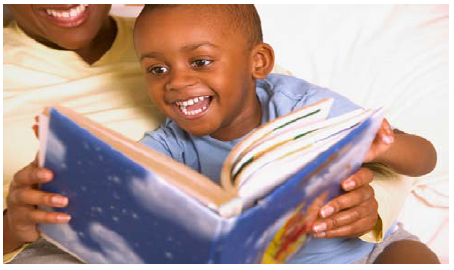Language and Literacy Skills
A variety of techniques can be used to promote the development of language and literacy skills in young children. Reading books together is a great way to nurture children’s early reading skills.
Select books that have content that is interesting to young children and is age-appropriate. Look for books that have illustrations that are engaging and appealing. Two effective ways to promote language and literacy skills is through interactive shared book reading and dialogic reading (Trivette & Dunst, 2007).
Interactive Shared Book Reading
Interactive shared book reading involves a variety of techniques designed to engage children in the story before, during and after the book reading (Trivette & Dunst, 2007).
Before reading the story, the teacher can point to the title or ask the children to make a prediction on what they think will happen during the story. During the interactive shared book reading, the teacher makes comments and poses questions about the story. Children are encouraged to share their ideas about the story. After the reading, the teacher and children discuss the story and make meaningful connections. The children are asked to reflect on how the story relates to their own world and experiences.

Dialogic Reading
Dialogic reading is similar to interactive reading using specific types of prompts to engage the child in becoming the storyteller (Whitehurst, 2012). Adults become the child’s audience as they listen and ask questions about the story. Two acronyms were developed in relationship to dialogic reading. They are PEER and CROWD.
PEER
P — Prompts: The adult uses prompts to encourage the child to discuss the book.
E — Evaluates: The adult evaluates the information given by the child.
E — Expands: The adult expands on the child’s response by elaborating on what the child has said.
R — Repeats: The adult repeats the original prompt to determine what the child has gained from the interaction.
For example, the adult says to the child, “What is in this picture?” (prompt). The child says, “A kitty” (evaluates). “Yes, it is a fluffy black and white kitten” (expands). “What is this?” (repeats prompt and points to picture). The child says, “A fluffy kitty.”
CROWD
There are a variety of prompts that can be used to promote discussion about a story. The acronym CROWD can help you remember five types of prompts. The following examples could be used with the book The Very Hungry Caterpillar by Eric Carle.
C — Completion: The children complete a sentence or phrase. “And he was still _______(hungry).”
R — Recall: The children are asked to recall some information from the story. “Can you remember the first food the caterpillar ate?”
O — Open-ended: The children share information about pictures in the book. “Tell me about what you see in this picture.”
W — Wh-questions: The children are asked questions that begin with “Wh,” such as what, where, when, and why. “Why do you think the caterpillar felt better after eating a green leaf?”
D — Distancing: The children make connections to their lives. “Have any of you ever had a stomachache?”
Advance Planning and Preparation
It is important to prepare for your book reading in advance. Take time to become comfortable with the book and story. Determine which prompts you will use prior to the book reading. You do not need to use all of the different prompts during one book reading. It is important to prepare for your book reading in advance. Take time to become comfortable with the book and story. Determine which prompts you will use prior to the book reading. You do not need to use all of the different prompts during one book reading.
Children benefit from multiple readings of the same book. Build and expand upon the prompts used with each book reading.
It may be helpful to write the prompts on post-it notes and place the notes on the corresponding pages in the book.
Think of questions that will promote the children’s interest and increase their comprehension of the story. Children will build understanding as they become engaged in discussing the concepts in the story.
Actively involve the children in the book reading (for example, have the children do actions such as pretending to swim as the character in the book swims). Acknowledge their contributions and ideas.
Be expressive and use different voices for various characters. This will help to hold the children’s attention.
Encourage the children to continue to explore and read the book after they read aloud.
References
Consortium on Reaching Excellence in Education, Inc. (2012). Sounds Beginnings: A workshop on early literacy. Instructors guide. Berkeley, CA: CORE.
Smith, M. W., Brady, J. P., & Anastosopoulos, L. (2008). Early language and literacy classroom observation – Pre-K tool. Baltimore, MD.: Paul H Brookes Publishing.
Trivette, C. M. & Dunst, C. J., (2007). Relative effectiveness of dialogic, interactive, and shared reading instruction, CELLreviews, 1(2), 1-12. Retrieved from Relative Effectiveness of Dialogic, Interactive, and Shared Reading Interventions.
Whitehurst, G. J. (2012). Dialogic reading: An effective way to read to preschoolers. Reading Rockets website. Retrieved from Dialogic Reading: An Effective Way to Read Aloud with Young Children.


